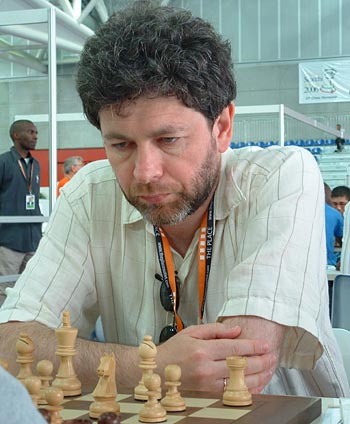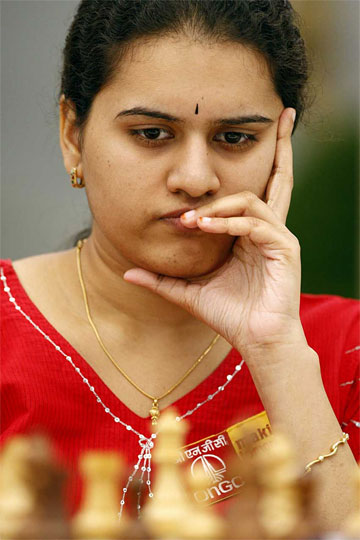| Latest | Greatest | Lobby | Journals | Search | Options | Help | Login |
|
|
|
This topic is archived. |
| Home » Discuss » Topic Forums » Sports |
|
| Jack Rabbit
|
Sun Apr-20-08 12:07 PM Original message |
| The Jack Rabbit Chess Report (April 20): Yank takes Gausdal; three majors start this week |
|
Edited on Sun Apr-20-08 12:34 PM by Jack Rabbit
Kaidanov wins Gausdal Classic
 Greg Kaidanov, a native of Soviet Ukraine who has lived in Kentucky since 1991, won the annual Guasdal Chess Classic in Norway today by a full point over his nearest rival, Geetha Naraynan Gopal of India. Mr. Kaidanov scored 7 points in nine rounds. winning four games without a loss. Greek grandmaster Vasilios Kotronias finished third with 5½ points. Kaidanov, 48, has been a grandmaster since 1988. He has played on several US Olympic teams. His greatest achievement came in 2002 when he won the Areoflot Open in Moscow. Three major tournaments open this week European Championships, Plovdiv  The ninth annual European Individual Championships begin tomorrow (Monday, April 21) in Plovdiv, Bulgaria. There are two competitions for the event, a general competition and a ladies' competition. So far, 332 participants have signed up for the general section and 165 women for the ladies' event. The top seeds in the general competition are Sergei Movsesian of Slovakia, Spain's Paco Vallejo and Ukrainian GM Andrei Volokitin. The women are led by Sweden's Pia Cramling, former women's wolrd champion Antonaeta Stefanova of Bulgaria and Polish IM Monika Socko. The event is scheduled for eleven rounds to conclude May 2 and any tie breaks necessary to be played on May 3. FIDE Grand Prix, Baku  The first leg of the FIDE Grand Prix gets underway on the shores of the Caspian Sea in Baku, the capital of Azerbaijan and birthplace of Garry Kasparov. There are 14 participants in the event: Magnus Carlsen (Norway), Shakhriyar Mamedyarov (Azerbaijan), Teimour Radjabov (Azerbaijan), Peter Svidler (Russia), Sergey Karjakin (Ukraine), Michael Adams (England), Gata Kamsky (United States), Alexander Grischuk (Russia), Etienne Bacrot (France), Ivan Cheparinov (Bulgaria), Wang Yue (China), Ernesto Inarkiev (Russia), Vugar Gashimov (Azerbaijan) and David Navara (Czechia). This is the first time 17-year-old Magnus Carlsen enters an international competition as the top seed. The event is a 13-game round robin and will conclude Monday, May 5. The Sofia Rules will be in effect, meaning that draw offers will have to be approved by an arbiter. Sigeman & Company Tournament, Malmø  The 16th annual Sigeman & Company starts Tuesday in Malmø, Sweden. This years participants are: Tiger Hillarp-Persson, Evgeny Agrest, Axel Smith and Ralf Akesson of Sweeden; Jan Timman and Daniel Stellwagen of Holland; and Lars Bo Hansen (Denmark), Kjetil Lie (Norway), Vasilios Kotronias (Greece) and, participating in the Sigeman for the first time, 71-year-young Lajos Portisch (Hungary). The event is a nine-game round robin and will conclude Wednesday, April 30. The tournament is sponsored by the law firm of Sigeman & Company, Malmø. |
| Printer Friendly | Permalink | | Top |
| Jack Rabbit
|
Sun Apr-20-08 12:08 PM Response to Original message |
| 1. Games from recent events |
|
Diagrams on the Jack Rabbit Chess Report are made with Chess Mérida, a true type font that can be downlaoded free here. !""""""""# $tMvWlVmT% $OoOoOoOo% $ + + + +% $+ + + + % $ + + + +% $+ + + + % $pPpPpPpP% $RnBqKbNr% /(((((((() WHITE White to move (This position is a theoretical draw) |
| Printer Friendly | Permalink | | Top |
| Jack Rabbit
|
Sun Apr-20-08 12:10 PM Response to Reply #1 |
| 2. Moskow - Kaidanov, Gausdal |
 Greg Kaidanov Eric Moskow - Greg Kaidanov Chess Classic, Round 7 Gausdal (Norway), 14 April 2008 English Queen's Gambit: Orthodox King's Fianchetto Defense (Agincourt Defense) 1.c4 e6 2.g3 d5 3.Bg2 g6 4.Nf3 Bg7 5.0-0 Ne7
6.d4 0-0
7.Nc3
7...Nbc6 8.cxd5 exd5 9.Bg5
9...f6!?
10.Bd2
10...Be6
11.Na4
11...b6 12.Rc1 Qd7
13.Qb3 Rac8
14.Bb4?!
14...Nxb4 15.Qxb4 Nf5 16.Rfd1
16...Rfe8 17.Bf1?
!""""""""# $ +t+t+l+% $O Ow+ Vo% $ O +vOo+% $+ +o+m+ % $nQ P + +% $+ + +nP % $pP +pP P% $+ Rr+ + % /(((((((() WHITE: Eric Moskow Position after 17.Bg2f1 17...Bh6!
18.Rc2
18...Nd6 19.Nd2
19...Bf5 20.Rcc1
!""""""""# $ +t+t+l+% $O Ow+ +o% $ O M OoV% $+ +o+v+ % $nQ P + +% $+ + + P % $pP NpP P% $+ Rr+bK % /(((((((() WHITE: Eric Moskow Position after 20.Rc2c1 20...Nc4!
21.Nxc4 Bxc1 22.Rxc1 dxc4
23.Rd1 c5 24.Qxc4+
24...Kg7 25.Nc3 cxd4 26.Qxd4 Qxd4
27.Rxd4 Rcd8 28.Rc4
28...Re7 29.b4 Rd2 30.a4
30...Rc2 31.e4 Be6 32.Nd5 Rxc4 33.Bxc4 Bxd5 34.Bxd5
34...Rc7 35.Kg2 Rc3 36.g4 g5 37.f3 Ra3
38.Bc6 Rb3 39.b5 Ra3 40.Kg3 Rxa4
41.h4 h6 42.hxg5 hxg5 43.Kf2 Ra3 44.Bb7 Rb3 45.Bc6 Rc3 46.Ke2 a5 0-1
|
| Printer Friendly | Permalink | | Top |
| Jack Rabbit
|
Sun Apr-20-08 12:13 PM Response to Reply #1 |
| 3. Smeets - Stellwagen, Dutch National Championships, Hilversum |
|
This is the deciding game played in the final round in Hilversum. Mh. Stellwagen entered the round leading the tournament, a half-point ahead of Mh. Smeets.
 Jan Smeets Jan Smeets - Daniel Stellwagen Dutch National Championships, Round 11 Hilversum, 13 April 2008 Open Sicilian Game: Taimanov Defense 1.e4 c5 2.Nf3 e6 3.d4 cxd4 4.Nxd4 Nc6 5.Nc3
5...Qc7 6.Be3
6...a6 7.f4 b5 8.Qf3
8...Bb7 9.Bd3 Nf6
10.g4 d6 11.0-0-0 Be7 12.Kb1 Nd7 13.g5 0-0 14.h4!?
14...Nc5 15.Nce2
15...Rac8 16.h5 Nxd4
17.Nxd4 f5 18.gxf6
18...Bxf6 19.Qg4 e5
20.Ne6 Nxe6 21.Qxe6+ Kh8
22.h6 g6 23.Rhf1 Qe7 24.Qb3 exf4 25.Bxf4 Be5
!""""""""# $ +t+ T L% $+v+ W +o% $o+ O +oP% $+o+ V + % $ + +pB +% $+q+b+ + % $pPp+ + +% $+k+r+r+ % /(((((((() WHITE: Jan Smeets Position after 25...Bf6e5 26.Bxe5+
26...dxe5 27.a4 b4
28.Rxf8+ Rxf8 29.c3
29...bxc3 30.Qxc3
30...g5 31.Bc4!?
31...Bxe4+ 32.Ka2 Bf5 33.Bxa6
33...Qe6+ 34.Bc4 Qxh6 35.Qxe5+
!""""""""# $ + + T L% $+ + + +o% $ + + + W% $+ + QvO % $p+b+ + +% $+ + + + % $kP + + +% $+ +r+ + % /(((((((() WHITE: Jan Smeets Position after 35.Qc6e5:p+ 35...Qg7 36.Qd6 g4!?
37.a5 g3?
38.Rg1 Ra8
39.a6 g2 !""""""""# $t+ + + L% $+ + + Wo% $p+ Q + +% $+ + +v+ % $ +b+ + +% $+ + + + % $kP + +o+% $+ + + R % /(((((((() WHITE: Jan Smeets Position after 39...g3g2 40.Qd5!
40...Re8
41.Qxf5 Qd4 42.Qf7 Rc8
43.Rxg2 Qxc4+ 44.Qxc4 Rxc4 45.Rg3 1-0
|
| Printer Friendly | Permalink | | Top |
| Jack Rabbit
|
Sun Apr-20-08 12:17 PM Response to Reply #1 |
| 4. Shirov - Andeikin, Russian Team Championships, Sochi |
|
Alexei Shirov played second board for the tournaments champions, Ural Ekaterininburg.
 Alexei Shirov Alexei Shirov (Ural Ekaterininburg) - Dmitry Andreikin (Economist-2 Saratov) Russian Team Championship, Round 2 Sochi, 3 April 2008 Closed German Game: Dreev Defense (Caro-Kann Defense) 1.e4 c6 2.d4 d5 3.e5 Bf5 4.Nc3 Qb6 5.Nf3
5...e6 6.Be2 Nd7 7.0-0 Ne7 8.b3 Bg6!?
9.Na4
9...Qd8 10.c4 Nf5 11.g4!?
11...Nh4!
12.Nxh4 Qxh4 13.cxd5 cxd5
14.Bf4?!
14...Qd8?!
15.Bg3
15...Rc8 16.f4 Be4 17.f5 exf5
18.gxf5 Qg5 19.Bf3 b5
20.Bxe4!
20...Qe3+?
21.Rf2 Qxe4
!""""""""# $ +t+lV T% $O +n+oOo% $ + + + +% $+o+oPp+ % $n+ Pw+ +% $+p+ + B % $p+ + R P% $+ +q+ K % /(((((((() WHITE: Alexei Shirov Position after 21...Qe3e4:B 22.Rc1!!
22...Rxc1 23.Qxc1 bxa4
24.Qc8+ Ke7 !""""""""# $ +q+ V T% $O +mLoOo% $ + + + +% $+ +oPp+ % $o+ Pw+ +% $+p+ + B % $p+ + R B% $+ + + K % /(((((((() WHITE: Alexei Shirov Position after 24...Ke8e7 25.f6+!
25...gxf6 26.exf6+ Nxf6 27.Qc5+ Kd8 28.Qc7+ Ke8 29.Qb8+ Kd7
30.Qxa7+
30...Ke8 31.Qb8+ Kd7 32.Qb5+ Kd8
33.Qb6+ Kd7
34.Rxf6 Qe3+ 35.Kg2 Qe2+ 36.Kh3 Qh5+ 37.Bh4
37...Be7
38.Qc6+ Kd8 39.Rd6# 1-0
|
| Printer Friendly | Permalink | | Top |
| Jack Rabbit
|
Sun Apr-20-08 12:20 PM Response to Reply #1 |
| 5. Adams - Caruana, Ruy López Festival, Mérida |
|
Edited on Sun Apr-20-08 01:17 PM by Jack Rabbit
English grandmaster Mickey Adams is the champion of this year's Ruy López Festival in Mérida.
 Mickey Adams Mickey Adams - Fabiano Caruana Ruy López Chess Festival, Round 6 Mérida, 10 April 2008 Open Sicilian Game: Kan Defense 1.e4 c5 2.Nf3 e6 3.d4 cxd4 4.Nxd4 a6 5.Bd3 Bc5
6.Nb3 Be7
7.0-0 d6 8.Qg4
8...g6 9.Qg3
9...Qc7!?
10.a4
10...b6
11.Na3!?
11...Bb7 12.Nc4
12...Nd7 13.Be3
13...Ngf6 14.f3 Rb8
15.Bh6 Nh5
16.Qh3 d5
17.exd5 Bxd5 18.Ncd2 b5
19.axb5 axb5 20.f4 Bd6
21.f5 Ne5?
!""""""""# $ T +l+ T% $+ W +o+o% $ + Vo+oB% $+o+v+ +n% $ + + + +% $+n+b+ +q% $ PpN +pP% $R + +rK % /(((((((() WHITE: Mickey Adams Position after 21...Nd7e5 22.Rae1!
22...Rg8
23.Be4 Ng4
24.Qxg4 Bxh2+ 25.Kh1 Ng3+
26.Kxh2 Nxf1+ 27.Kg1 Nxd2 28.Nxd2 Qb6+
29.Be3 Qc6 30.Bxd5 Qxd5 31.Ne4 1-0
|
| Printer Friendly | Permalink | | Top |
| Jack Rabbit
|
Sun Apr-20-08 12:26 PM Response to Reply #1 |
| 6. Koneru - Pérez, Ruy López Festival, Mérida |
|
Koneru Humpy is the world's second ranked woman player after Judit Polgar. She finish tied for third in Mérida.
 Koneru Humpy Koneru Humpy - Manuel Pérez Candelario Ruy López Chess Festival, Round 6 Mérida, 10 April 2008 Semi-Slav Queen's Gambit: Stoltz Opening 1.d4 d5 2.c4 e6 3.Nc3 c6 4.e3 Nf6 5.Nf3 Nbd7 6.Qc2 Bd6 7.Bd3
7...0-0 8.0-0 dxc4 9.Bxc4 b5
10.Be2 Bb7 11.Rd1 Qb8
12.e4 e5 13.dxe5
13...Nxe5 14.Nd4 Neg4!?
15.g3
15...g6 16.Bf3 a6?!
17.Nb3?!
17...Bc8?
18.h3
18...Ne5
19.Bg2 Nh5
!""""""""# $tWv+ Tl+% $+ + +o+o% $o+oV +o+% $+o+ M +m% $ + +p+ +% $+nN + Pp% $pPq+ Pb+% $R Br+ K % /(((((((() WHITE: Koneru Humpy Position after 19...Nf6h5 20.f4!!
20...Nc4 21.e5!
21...Bc7
22.g4 Qa7+
23.Kh1
23...Ng3+ 24.Kh2 f6
!""""""""# $t+v+ Tl+% $W V + +o% $o+o+ Oo+% $+o+ P +m% $ +m+ Pp+% $+nN + Mp% $pPq+ +bK% $R Br+ + % /(((((((() WHITE: Koneru Humpy Position after 24...f7f6 25.Nd4!
25...Nf1+
26.Bxf1 fxe5 27.Nxc6
27...Qc5 28.Bg2 exf4 29.Bd5+ Be6 30.Bxe6+ Kh8 31.Nd5 1-0
|
| Printer Friendly | Permalink | | Top |
| Jack Rabbit
|
Mon Apr-21-08 01:02 PM Response to Original message |
| 7. Official websites for tournaments starting this week |
| Printer Friendly | Permalink | | Top |
| DU
AdBot (1000+ posts) |
Thu Apr 25th 2024, 08:05 AM Response to Original message |
| Advertisements [?] |
| Top |
| Home » Discuss » Topic Forums » Sports |
|
Powered by DCForum+ Version 1.1 Copyright 1997-2002 DCScripts.com
Software has been extensively modified by the DU administrators
Important Notices: By participating on this discussion board, visitors agree to abide by the rules outlined on our Rules page. Messages posted on the Democratic Underground Discussion Forums are the opinions of the individuals who post them, and do not necessarily represent the opinions of Democratic Underground, LLC.
Home | Discussion Forums | Journals | Store | Donate
About DU | Contact Us | Privacy Policy
Got a message for Democratic Underground? Click here to send us a message.
© 2001 - 2011 Democratic Underground, LLC